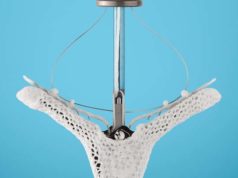
A first-in-man study indicates that percutaneous edge-to-edge repair with Abbott Vascular’s MitraClip system is a safe and feasible treatment for tricuspid regurgitation. According to the study, successful reduction of tricuspid regurgitation with MitraClip was associated with favourable short-term outcomes both in patients undergoing isolated tricuspid repair and those undergoing combined mitral and tricuspid valve repair for severe regurgitation.
Speaking at PCR London Valves (18–20 September, London, UK), Jörg Hausleiter (Medizinische Klinik and Poliklinik I, Ludwig-Maximilians Universität München, Munich, Germany) reported that the rationale of the study was to investigate the “procedural feasibility, safety, short-term durability, and clinical outcomes at 30 days” of using the MitraClip to treat “selected, highly symptomatic patients with severe tricuspid regurgitation”.
Of the 18 patients enrolled in this retrospective analysis of compassionate use cases, six had isolated tricuspid regurgitation and 12 had combined mitral regurgitation and tricuspid regurgitation. All patients have been seen by the heart team and were considered as non-operable after exhaustion of optimal heart failure medication. Furthermore, 12 were in New York Heart Association (NYHA) class III with the remaining six being in NYHA class IV. All patients had tricuspid regurgitation grade 2+ or above—with the majority having tricuspid regurgitation grade 3+ or 4+. Hausleiter commented that the MitraClip was delivered though the transfemoral approach and there was “combined use of transoesophageal echocardiography (TOE) and transthoracic echocardiogram for steering and crasping”. Additionally, Hausleiter et al used a modified steering technique of the clip delivery system “to achieve perpendicular trajectory to the tricuspid valve”.
Overall, 41 clips were placed (2.3±0.7 per patient) and a “successful”—reduction of tricuspid regurgitation by at least one degree—was achieved in 100% of patients. There were no in-hospital deaths, strokes myocardial infarctions, or repeat interventions. By 30 days, one patient had had a stroke and one patient had undergone repeat intervention but none had died or experienced myocardial infarction. Furthermore, there was no reported bleeding at either timepoint.
According to the 30-day echocardiographic results, 70% of patients were in grade 1+ or grade 2+ tricuspid regurgitation. Improvements were also observed in NYHA functional class—with most patients in NYHA III or NYHA III and none in NYHA class IV.
Hausleiter commented: “Transcatheter repair of the tricuspid valve using the MitraClip system in selected patients is feasible, safe, and is associated with good short-term durability. Furthermore, the successful interventional reduction of tricuspid regurgitation appears to be associated with favourable short-term outcomes in patients undergoing isolated tricuspid repair or combined mitral and tricuspid repair.”
MitraClip is not the only mitral repair device now being considered for use in the tricuspid valve. During PCR Innovators Day (18 September), Karl-Heinz Kuck (Department of Cardiology, Asklepios Klinik St. Georg, Hamburg, Germany) presented data from a first-in-man study that used an adapted version of Valtech’s Cardioband (a direct annuloplasty system) for tricuspid repair. Kuck reported that, based on the results of the study, the use of Cardioband for tricuspid repair is “feasible and safe”. He added that a CE mark study of the system, for use in the tricuspid valve, has now been initiated.












